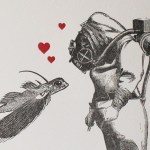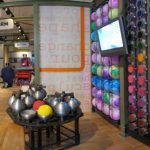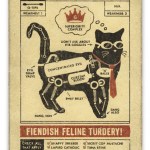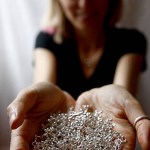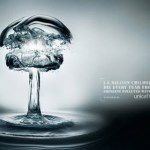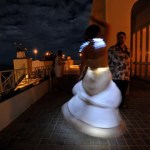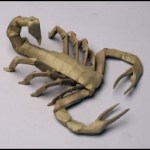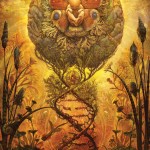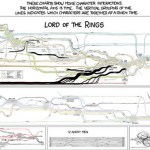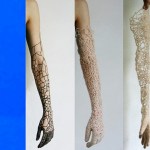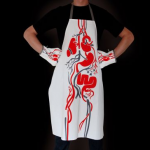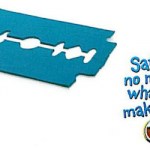design
A short (~4 minute) sweet overview of the political power of data visualization, by Tufte disciple Alex Lundry. He says so-called "dataviz" exists (you guessed it) "at the intersection of art and science." Quite right, sir!
You'll note Lundry makes use of the classic pirates-global warming relationship, Tufte's "pie charts suck" message, and so on. It's one of several good videos from a great event I really want to get to - igniteDC. I'd also like to mention that I'll be reviewing Connie Malamed's new book, Visual Language, which appears near the end of the video, in about a week or so, so…
Charmanders and Squirtles are fascinating creatures--but being fictional, they place pretty low on the relevancy scale. Still, kids of all ages are obsessed with Pokémon, and David Ng on The World's Fair wants to turn that admiration toward real creatures so that we might better learn and care about the lifeforms on our planet. The project is called Phylomon, and all creative and scientific types are invited to produce illustrations, write content, and design gameplay for the cause. Jessica Palmer sees big potential on Bioephemera, writing this is a chance for kids "to discover that real…
Attention all art/science web-collaborative types! Dave Ng has just formally announced the Phylomon Project. Here's the hook: a paper published in 2000 determined that an 8 year old could identify and characterize 120 different Pokemon characters, but when it comes to animals in their own backyard, kids have no clue.
There's nothing wrong with kids having rich fantasy worlds - far from it. But why not give them the chance to discover that real biology is also incredibly cool - not to mention complex, beautiful, and for many kids, right outside their back door? Maybe I'm showing my age, but…
To follow up on my previous review of KC Cole's book about the Exploratorium, here's a nifty exhibit called "How People Make Things." It's a traveling exhibit (by the Children's Museum of Pittsburgh, not the Exploratorium) that demonstrates the basics of manufacturing processes like injection molding and assembly.
It's interesting to compare the experience you may imagine having in the exhibit room above to the experience of the website, which uses a one-directional lecture mode (warning: be prepared for the Mr. Rogers cameo). It's ironically difficult to successfully translate hands-on…
artwork by Ryan Abblegen, via iO9.
(Since he was BoingBoinged, his etsy shop is all out of mechanized murder cards, so bookmark him for after the holidays).
Photo: Jana Asenbrennerova / The Chronicle
SFGate has a great interview with Raven Hanna of madewithmolecules! I love Raven's stuff an am thrilled to see her getting recognition.
A question I used to get fairly frequently is "what medical advance has saved the most lives?" Guesses usually include antibiotics, vaccines, and septic surgical method, but it's probably. . . clean water. Not a medical advance, you say? Maybe not, at least the way most people think of medicine - but sadly there are still many parts of the world that can't take clean water for granted.
Via John at Tracing Resistance Blog.
Dress by Alison Lewis,
Photography by Carlos Linares III.
Read all about it at iheartswitch.
Origami is as ephemeral as art gets - delicate paper, with no more than creases and physics to maintain its shape. It's also the ideal art form for blurring the boundary between art and science, because it's all about geometry. You could argue that the origami medium is math, just as much as it's paper.
That's why Between the Folds, a documentary film by Vanessa Gould about origami-happy artists, mathematicians and scientists "working in the shadows between art and math," is such a success: the connections between math, science, art and paper aren't strained at all, so you can sit back and…
The best Lady Gaga parody yet? Judge for yourself:
I lay it out like they do in magazines
check out this typeface it's like smoking nicotine (I love it)
using Adobe's not the same without a Mac
if it was lead it would be lined up on a track
Oh yeah! Via Jennifer Ouellette.
The beautiful 2009 Burning Man poster, by artists Corey and Catska Ench, portrays evolution as a fantasia of related patterns.
I'm currently attending the Grand Opening of the new Laboratory at Harvard University, "an exhibition and meeting space for student idea development within and between the arts and sciences," for a special colloquium on Art, Science, and Creativity featuring David Edwards (author of ArtScience), Lisa Randall, and others. This is awesome. Stay tuned for a report tomorrow.
In case you didn't see it, the latest xkcd is a visual shout-out to data visualization guru Edward Tufte's favorite map, this 1861 depiction of Napoleon's march on Moscow, by Charles Joseph Minard. Yay!
Movie Narrative Charts
Charles Minard's 1869 chart showing the losses in men, their movements, and the temperature of Napoleon's 1812 Russian campaign.
What if your clothes grew themselves in response to your body's temperature, becoming thicker in areas that needed more insulation and thinner in areas that were warm enough?
Sounds pretty much ideal. No worrying about whether you're going to need a scarf later in the evening or if a down parka was maybe not the right choice. But what if the clothing in question was made up of bacteria? Specifically, the bacteria on your own skin?
Austrian designer Sonja Bäumel envisioned this most organic of textiles in "Crocheted Membrane," one in a four-part series of experiments exploring the…
Via Inventorspot: Hello Kitty goes anatomical, and we discover she even has bows on her guts. Yikes!
But seriously - the second, faux-ivory Hello Kitty looks a little familiar. According to Inventorspot,
you can choose from regular style or an interesting antiqued version with a finish resembling aged ivory. This style is meant to look like a netsuke; a polished and sculpted toggle worn by Japanese citizens and samurai on their kimono sashes from the 17th century on - robes have no pockets, y'see.
A netsuke? Sure. But to me, ivory + anatomy = anatomical teaching models like these. (see also…
Okay, so this apron by Aksel Varichon is awesome. Very fun. But what's with the oven mitt?
If the premise of the apron is that we're seeing internal anatomy partially revealed on the wearer's body, doesn't the matching mitt imply that we have little hearts and kidneys in our wrists?
The artist also makes tablecloths and placemats with similar designs, but those don't really bother me, because it's not like your table has viscera to be revealed. I'll admit, it's not like the apron's anatomy is accurate - it has one lung, a really bizarre circulatory system, and it's missing many major…
Consumerist.com is concerned about these Singaporean Play-Doh ads:
Ummm, well, hmmm. That's kind of creepy, isn't it?
According to the Consumerist,
These Play Doh ads from Singapore don't seem to be aimed at kids. Then again, the message "safe no matter what you make" seems to be aimed directly at parents of kids who play with Play Doh, which leads us back to our initial thought, which is wtf kind of kid requiring parental supervision is shaping eerily realistic looking bottles of pills and razor blades for fun?
The Consumerist's source, UglyDoggy, has the other ads in the series -…
Okay, if you're anything like me, you don't have time to read the blogs you already follow. But I do recommend that everyone head over to SEED's Revolutionary Minds Think Tank, where Greg Smith is guiding a conversation on visualizing science.
That's where I found the video above, demonstrating the UCSD Software Studies Initiative's application of "cultural analytics" to Rothko's paintings. When the paintings are treated as data points over an artist's career, they can be compared and contrasted in untraditional ways, revealing new patterns and anomalies. Awesome find!
Here, Smith responds…
"It will die, eventually, because no one will know how to do it." But for now, a few miles from here, Firefly Press' John Kristensen is keeping the tradition of letterpress alive, as seen in this beautiful video by Chuck Kraemer.
Via NOTCOT.
